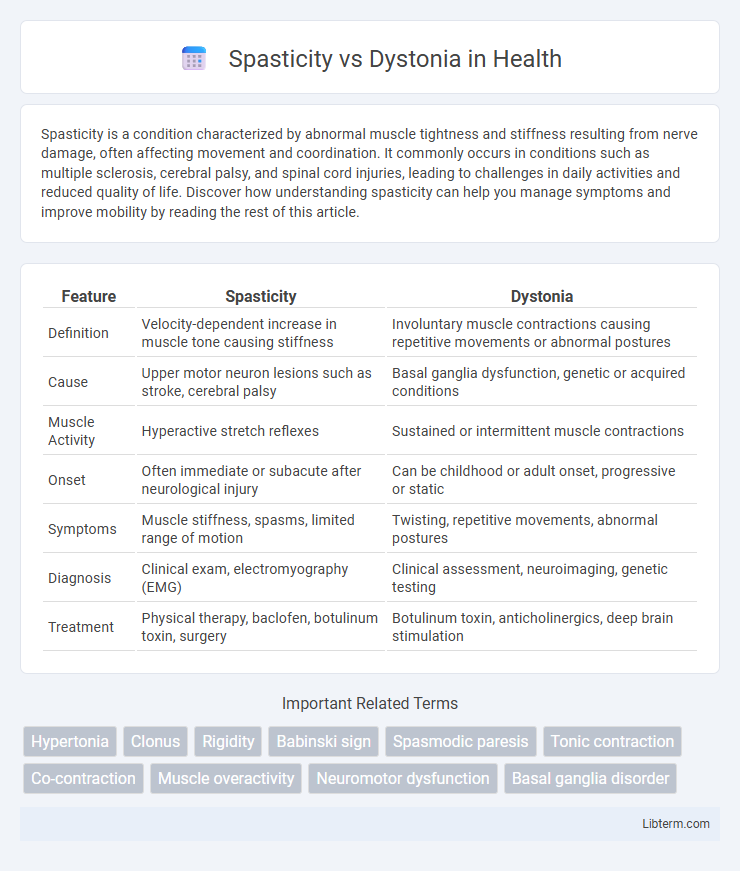Spasticity is a condition characterized by abnormal muscle tightness and stiffness resulting from nerve damage, often affecting movement and coordination. It commonly occurs in conditions such as multiple sclerosis, cerebral palsy, and spinal cord injuries, leading to challenges in daily activities and reduced quality of life. Discover how understanding spasticity can help you manage symptoms and improve mobility by reading the rest of this article.
Table of Comparison
| Feature | Spasticity | Dystonia |
|---|---|---|
| Definition | Velocity-dependent increase in muscle tone causing stiffness | Involuntary muscle contractions causing repetitive movements or abnormal postures |
| Cause | Upper motor neuron lesions such as stroke, cerebral palsy | Basal ganglia dysfunction, genetic or acquired conditions |
| Muscle Activity | Hyperactive stretch reflexes | Sustained or intermittent muscle contractions |
| Onset | Often immediate or subacute after neurological injury | Can be childhood or adult onset, progressive or static |
| Symptoms | Muscle stiffness, spasms, limited range of motion | Twisting, repetitive movements, abnormal postures |
| Diagnosis | Clinical exam, electromyography (EMG) | Clinical assessment, neuroimaging, genetic testing |
| Treatment | Physical therapy, baclofen, botulinum toxin, surgery | Botulinum toxin, anticholinergics, deep brain stimulation |
Understanding Spasticity: Definition and Causes
Spasticity is a motor disorder characterized by velocity-dependent increase in muscle tone resulting from hyperexcitability of the stretch reflex, often caused by upper motor neuron lesions such as stroke, multiple sclerosis, or cerebral palsy. It leads to stiff, rigid muscles that impair voluntary movement and cause muscle spasms. Understanding the underlying neurophysiological mechanisms helps differentiate spasticity from dystonia, which involves involuntary muscle contractions causing twisting and repetitive movements.
Dystonia Explained: Key Characteristics and Triggers
Dystonia is a neurological movement disorder characterized by involuntary muscle contractions that cause twisting, repetitive movements, or abnormal postures. Key characteristics include sustained muscle contractions and abnormal muscle co-activation, often worsening with voluntary movement or stress. Common triggers for dystonia include fatigue, anxiety, sensory stimuli, and certain medications, which can exacerbate symptoms and impact daily functioning.
Neurological Pathways: Spasticity vs Dystonia
Spasticity results from damage to the upper motor neurons in the corticospinal tract, causing hyperexcitability of the stretch reflex due to impaired inhibitory signals. Dystonia involves dysfunction in the basal ganglia circuitry, particularly affecting the sensorimotor integration and leading to abnormal, involuntary muscle contractions. While spasticity primarily reflects disruption in pyramidal pathways, dystonia arises from maladaptive plasticity and altered neurotransmitter activity in extrapyramidal motor circuits.
Clinical Presentation: How Spasticity and Dystonia Differ
Spasticity is characterized by velocity-dependent increased muscle tone and exaggerated tendon reflexes, often presenting as stiffness and resistance to passive movement. Dystonia involves sustained or intermittent muscle contractions causing abnormal, repetitive movements or postures, often task-specific and fluctuating in severity. While spasticity primarily affects muscle tone related to upper motor neuron lesions, dystonia is a disorder of involuntary muscle contractions linked to basal ganglia dysfunction.
Diagnostic Criteria for Spasticity and Dystonia
Spasticity is characterized by a velocity-dependent increase in muscle tone and hyperactive stretch reflexes, typically assessed using the Modified Ashworth Scale or the Tardieu Scale during physical examination. Dystonia is diagnosed through clinical observation of sustained or intermittent muscle contractions causing abnormal, repetitive movements or postures, with criteria including the identification of task specificity, sensory tricks, and the presence of patterned muscle activation. Electromyography (EMG) and neuroimaging may support diagnosis by revealing distinct neuromuscular activation patterns in dystonia, whereas spasticity is primarily evaluated by neurological examination focused on reflex modulation and muscle tone changes.
Impact on Daily Life and Motor Function
Spasticity, characterized by velocity-dependent muscle stiffness, often limits smooth voluntary movements and can cause muscle fatigue, impacting walking, dressing, and other daily tasks. Dystonia involves sustained or intermittent muscle contractions leading to abnormal postures or repetitive movements, severely disrupting fine motor skills and coordination essential for activities like writing or eating. Both conditions impair motor function but differently affect muscle tone and control, necessitating tailored therapeutic approaches to enhance independence and quality of life.
Treatment Approaches: Spasticity vs Dystonia
Treatment approaches for spasticity primarily include muscle relaxants such as baclofen and tizanidine, physical therapy, and botulinum toxin injections to reduce muscle stiffness and improve range of motion. Dystonia management often involves oral medications like anticholinergics and benzodiazepines, botulinum toxin injections targeting overactive muscles, and deep brain stimulation for severe cases. Both conditions benefit from tailored rehabilitation strategies, but dystonia treatments focus more on modulating abnormal muscle contractions and spasms through neurological interventions.
Rehabilitation Strategies for Each Condition
Rehabilitation strategies for spasticity focus on reducing muscle stiffness and improving motor control through physical therapy, stretching exercises, and use of modalities like electrical stimulation or botulinum toxin injections. For dystonia, therapy aims to normalize abnormal muscle contractions using sensorimotor retraining, task-specific exercises, and sometimes deep brain stimulation or oral medications to manage involuntary movements. Both conditions benefit from tailored, multidisciplinary approaches incorporating occupational therapy and assistive devices to enhance functional independence.
Prognosis and Long-term Management
Spasticity, characterized by velocity-dependent increased muscle tone, often results from upper motor neuron lesions and typically improves with consistent physical therapy, botulinum toxin injections, and pharmacologic interventions, leading to a variable prognosis depending on the underlying condition. Dystonia, defined by sustained or intermittent muscle contractions causing abnormal postures, usually requires a combination of oral medications, deep brain stimulation, and physical rehabilitation, with prognosis largely influenced by the dystonia subtype and responsiveness to treatment. Long-term management for both conditions emphasizes multidisciplinary approaches, including neurology, physical therapy, and pain management, to optimize functional outcomes and reduce disability.
Future Research and Emerging Therapies
Future research on spasticity and dystonia prioritizes identifying distinct neurobiological mechanisms to develop targeted therapies. Emerging treatments include gene therapy, neuromodulation techniques like deep brain stimulation, and novel pharmacological agents aimed at modulating neurotransmitter pathways. Advanced neuroimaging and biomarker studies are improving diagnostics and personalized intervention strategies for these movement disorders.
Spasticity Infographic

 libterm.com
libterm.com